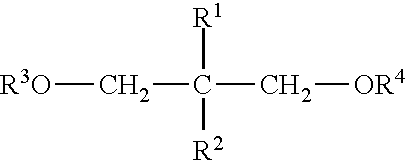Producing propylene impact copolymers and products
a technology of impact copolymer and propylene, which is applied in the field of propylene impact copolymer production, can solve the problems of particle stickiness, particle agglomeration, surface of powder particles to become sticky, etc., and achieves high fc values, high fc content, and strong temperature dependence of fc capability.
- Summary
- Abstract
- Description
- Claims
- Application Information
AI Technical Summary
Benefits of technology
Problems solved by technology
Method used
Image
Examples
examples
Test Method
[0086]Cup Test Index is determined by a method developed in-house to measure powder flowability of high rubber content polypropylene impact copolymer powder. It is especially useful when resin tends to get sticky and angle of repose methods are difficult. The method procedure consists of filling a polystyrene cup (typically used for coffee) with resin powder. The cup is then inverted on a flat surface for 10 minutes. The cup is then removed and the tester then observes the shape of the powder and how long it takes to deform and collapse from the initial cup shape. The cup test results are also correlated to operational issues at a typical commercial gas phase polymerization unit operating the UNIPOL® Polypropylene process, which is available for license by W.R. Grace & Co.—Conn and / or its affiliates. Table 1 lists the Cup Index and typical operational issues.
TABLE 1CupPowder shapeTypical OperationalTestretention timeConsequences to PowderIndex(10 min test)Handling System0...
PUM
| Property | Measurement | Unit |
|---|---|---|
| reactor temperature | aaaaa | aaaaa |
| reactor temperature | aaaaa | aaaaa |
| reactor temperature | aaaaa | aaaaa |
Abstract
Description
Claims
Application Information
 Login to View More
Login to View More - R&D
- Intellectual Property
- Life Sciences
- Materials
- Tech Scout
- Unparalleled Data Quality
- Higher Quality Content
- 60% Fewer Hallucinations
Browse by: Latest US Patents, China's latest patents, Technical Efficacy Thesaurus, Application Domain, Technology Topic, Popular Technical Reports.
© 2025 PatSnap. All rights reserved.Legal|Privacy policy|Modern Slavery Act Transparency Statement|Sitemap|About US| Contact US: help@patsnap.com



